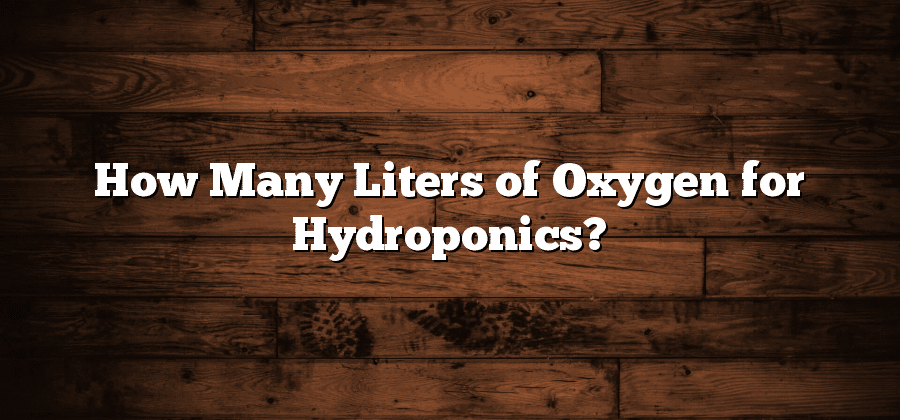Oxygen requirements for hydroponic systems
Hydroponic systems rely on a constant supply of oxygen to support the growth and development of plants. Oxygen plays a crucial role in the essential processes of respiration and nutrient uptake in hydroponics. Without adequate oxygen levels, plants may experience stunted growth, root rot, and nutrient deficiencies.
The oxygen requirements for hydroponic systems depend on various factors, including the type of plants being grown, the water temperature, and the nutrient solution used. Most hydroponic plants require oxygen levels of at least 6-8 parts per million (ppm) to ensure optimal growth. However, some sensitive crops may require even higher levels, reaching up to 10-12 ppm. It is important for hydroponic growers to regularly monitor and maintain appropriate oxygen levels to promote healthy plant growth and maximize crop yields.
The importance of oxygen in hydroponics
Hydroponics is a soilless cultivation method that relies on a nutrient-rich water solution to provide plants with the necessary elements for growth. In this unique system, one of the most critical components for success is oxygen. While many of us may not immediately associate oxygen with plant growth, it plays a vital role in maintaining optimal conditions for hydroponic crops.
Oxygen is essential in hydroponics because it allows the roots to obtain the necessary nutrients from the water solution. In traditional soil-based cultivation, plants rely on the air spaces within the soil to access oxygen. However, in hydroponics, the plants’ roots are submerged in water, which means oxygen must be readily available within the solution itself. This oxygen is crucial for not only nutrient absorption but also for healthy root development, preventing root rot, and promoting overall plant growth. Without sufficient oxygen levels, plants in hydroponic systems can experience stunted growth and be more susceptible to various diseases and root-related complications.
Factors affecting oxygen levels in hydroponic systems
Factors affecting oxygen levels in hydroponic systems can greatly impact the overall success and health of plants. One significant factor is the type and size of the oxygenation system used. The method of oxygen delivery, whether it is through diffusers, air stones, or sprayers, can all have different effects on oxygen levels. Additionally, the capacity and efficiency of the system can also play a role in how well oxygen is distributed throughout the hydroponic solution. It is crucial to carefully choose an oxygenation system that is appropriate for the specific needs of the crops being grown.
Another factor that can affect oxygen levels in hydroponic systems is the temperature of the growing environment. Warmer temperatures can decrease the amount of dissolved oxygen that the water can hold, leading to lower oxygen levels for the plants. This can be particularly challenging during periods of high heat. It is essential to monitor the temperature and take appropriate measures to ensure that the plants have sufficient oxygen, such as using supplemental cooling or adjusting the water temperature accordingly. By addressing these factors, hydroponic growers can optimize oxygen levels in their systems and provide a healthy growing environment for their plants.
Methods to measure oxygen levels in hydroponics
There are several methods available to accurately measure the oxygen levels in hydroponic systems. One common method is the use of dissolved oxygen meters or probes. These meters work by measuring the amount of dissolved oxygen in the nutrient solution. They provide real-time readings and are usually equipped with a digital display for easy monitoring. Dissolved oxygen meters are highly accurate and reliable, making them a popular choice among hydroponic growers.
Another method to measure oxygen levels is the use of oxygen sensors. These sensors are typically placed inside the nutrient solution and can provide continuous monitoring of oxygen levels. They work by detecting changes in the oxygen concentration and converting it into an electrical signal. Oxygen sensors are known for their high sensitivity and rapid response time, allowing growers to quickly identify any fluctuations in oxygen levels. By utilizing these measurement methods, hydroponic growers can ensure that their plants have an optimal oxygen supply, promoting healthy growth and maximizing yields.
The ideal oxygen levels for different hydroponic crops
In hydroponic systems, maintaining the ideal oxygen levels is crucial for the successful growth of different crops. Oxygen plays a vital role in nutrient uptake and root respiration, ensuring that plants receive the necessary oxygen for their metabolic processes. However, different hydroponic crops have varying oxygen requirements due to their specific growth characteristics and nutrient absorption capacities.
For leafy greens and herbs like lettuce or basil, the ideal oxygen levels generally range between 6-8 mg/L. These crops tend to have shallower root systems and higher water requirements, making them more susceptible to oxygen deficiencies. By maintaining optimal oxygen levels, growers can ensure vigorous root development and prevent issues such as root rot.
On the other hand, fruiting crops like tomatoes or peppers have slightly higher oxygen requirements, typically around 8-10 mg/L. These crops have deeper root systems and greater nutrient demands, necessitating adequate oxygenation to support their growth and productivity. By supplying sufficient oxygen, growers can improve nutrient absorption, enhance fruit quality, and maximize yields.
Understanding the specific oxygen needs of different hydroponic crops is crucial for optimizing their growth and overall health. By regularly monitoring and adjusting oxygen levels within hydroponic systems, growers can create an ideal environment for each crop, ensuring their success in this innovative and efficient method of cultivation.






